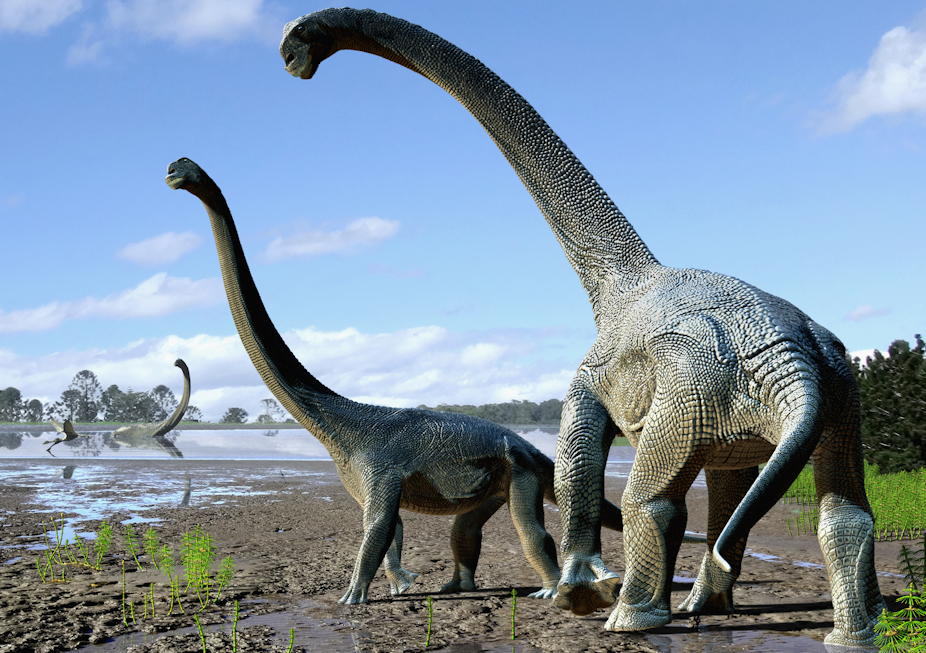The outback region around Winton in central Queensland is arguably Australia’s ground zero for giant dinosaur fossils. Here, graziers occasionally stumble across petrified bones on their paddocks, amid the stubbly grass and cow dung.
These bones appear like the living dead, rising from the underworld by an unusual process whereby the wetting and drying of the clay-rich soil works like a convection current, slowing bringing rocks and sometimes fossils to the surface. In the past, these stray bones would have been picked up and slung into the back of a ute, leaving researchers wondering what became of the rest of the animal.
In recent years, researchers from the Australian Age of Dinosaurs Museum (AAOD) in Winton have been returning to some of these old sites, and finding dozens of new ones with the help of bulldozers. They have been digging down through the deep soil to the bedrock below – the source of these fossil relics.
Their unconventional methods have proved incredibly fruitful. In 2009, palaeontologist Scott Hocknull and a team from the Queensland Museum and the AAOD named three new species of dinosaur: the long-necked sauropods Diamantinasaurus and Wintonotitan, and a huge predatory dinosaur, Australovenator.
Since then, another palaeontologist working with the AAOD, Steven Poropat, has been dodging the bulldozer’s blade and watching keenly during the early stages of each excavation for the telltale glint of bone among the freshly exposed rocks before it is crushed by the dozer’s tracks.
Savannasaurus, the little titanosaur
Enter Savannasaurus, Australia’s newest face in the world of dinosaurs, a long-necked plant-eater named by Poropat and his team today in the journal Scientific Reports. The new skeleton includes most of the vertebrae from the back, parts of the hips, forelimb and a scattering of ribs, foot bones, neck and tail vertebrae.

It was a fairly small animal as far as sauropods are concerned, perhaps measuring around 12-15m long based on the published drawings, but belongs to a group known ominously as the titanosaurs, which were most common in Asia and South America.
Poropat and his team also found further remains of Diamantinasaurus, which included part of its skull – the first sauropod skull unearthed in Australia. Together, the new fossils show that these two species were closely related within the titanosaur family.
Based on the timing of the breakup of the Gondwanan supercontinent, Poporat and his colleagues believe that Savannasaurus’ titanosaur ancestors probably made their one-way trek to Australia from South America via Antarctia during the mid-Cretaceous, some 105–100 million years ago.
The similarities between South America’s and Australia’s dinosaurs have been recognised before. In fact, my own research has found evidence that Australia may have bequeathed to South America its own cohort of carnivorous dinosaurs – a group called the megaraptorids, of which Australovenator was a member.
Exactly how and when they arrived is somewhat contentious. Given the general paucity of Australian dinosaur fossils as a whole, the final word is still out regarding who begat whom. One of the major hindrances faced by Australian palaeontologists is the limited timeframe in which their fossils are found. The most productive dinosaur localities in Australia are clustered between 115 million and 100 million years old; spanning a mere 10% of the known time that dinosaurs ruled the Earth.
What happened before and after this time slice is very poorly understood. Poropat and his team, as they put it, provide a framework within which new discoveries can be assessed. We’ve got a long way to go, but then again, science can only move forward once the first step is taken.

